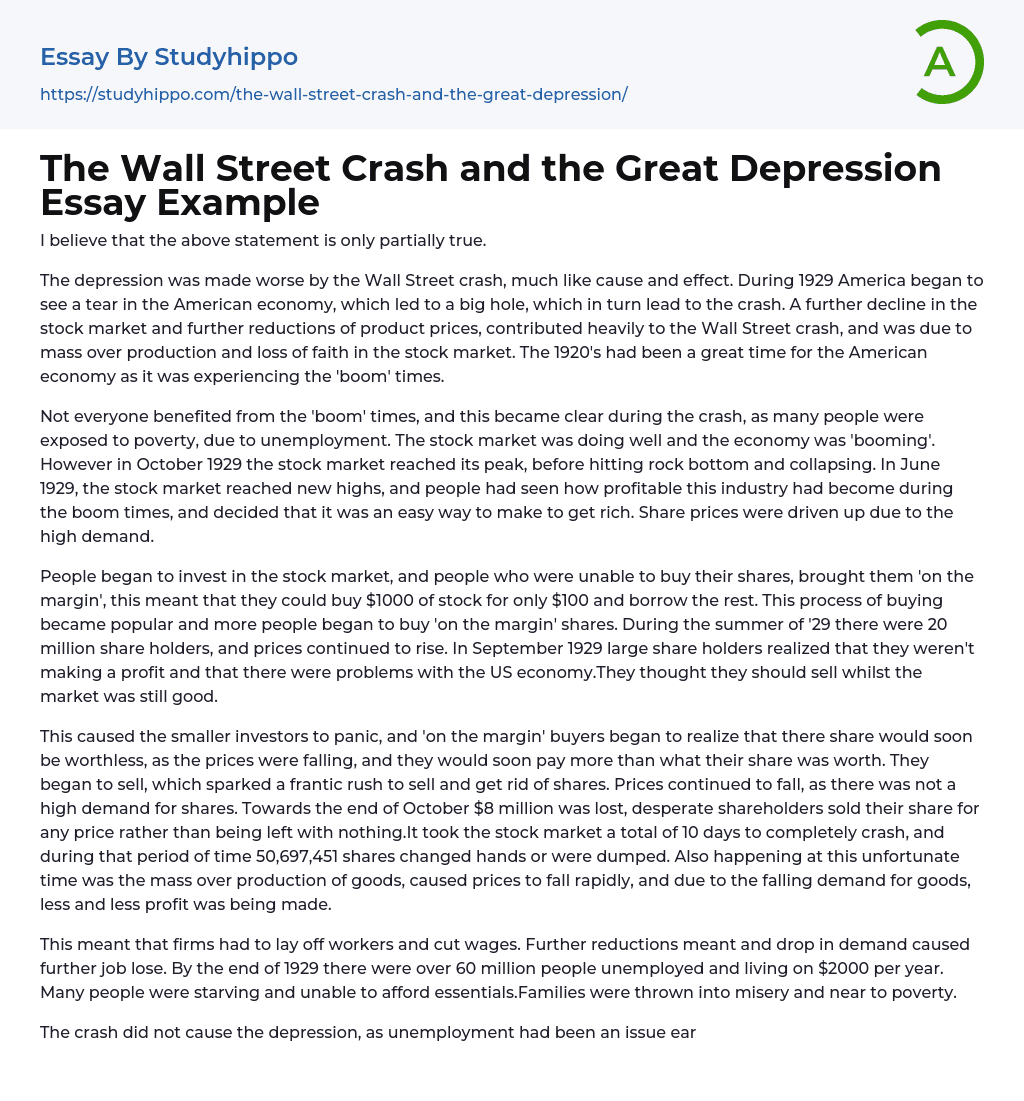

The Wall Street Crash and the Great Depression Essay Example
To my mind, the assertion mentioned beforehand is only partially correct.
The decline in both stock market and product prices leading up to the Wall Street crash had a cause and effect relationship with the worsening depression in America. The significant economic downturn that began in 1929 resulted in a massive deficit due to oversupply of goods and loss of confidence in the stock market, ultimately causing the crash. Despite colloquially being called 'boom' times for the American economy, these circumstances caused a drastic change.
Despite the flourishing economy and prosperous stock market, not all individuals were able to reap the benefits during this period of growth. The disparity among classes was brought to light when a subsequent crash resulted in widespread poverty as a result of unemployment. In October 1929, after reaching new heights in June of that yea
...r, the stock market reached its pinnacle before experiencing a significant decline. Many believed investing in the industry would be an easy route to wealth, ultimately leading to high demand and surging share prices.
Investment in the stock market became prevalent, where some people who couldn't afford to purchase shares bought them 'on the margin'. This involved buying $1000 of stock by borrowing the remainder. This trend became popularized attracting more investors who also bought 'on the margin'. By summer of 1929, there were 20 million shareholders and prices kept on rising. However, by September of that year, major shareholders recognized the profit loss and further economic difficulties faced by the United States. They deemed it wise to exit whilst the market was favorable.
As prices began to fall, smaller investors panicked and those who bought shares 'on the margin'
realized their shares were becoming worthless and would soon be worth less than what they paid for them. This realization led them to sell their shares, causing a rush of panicked selling. The lack of demand for shares resulted in continuously falling prices. The stock market crashed in just 10 days, with over 50 million shares changing hands. During this time, shareholders sold their shares at any price rather than having nothing; resulting in a loss of $8 million by the end of October. To worsen the situation, mass overproduction caused prices of goods to drop rapidly, resulting in less profit due to declining demand.
This resulted in companies having to dismiss employees and reduce salaries, leading to a decrease in demand and further job losses. By the conclusion of 1929, more than 60 million individuals were jobless and surviving on a yearly income of $2000. This left many individuals starving and incapable of purchasing necessities, causing families to undergo anguish and near destitution.
The Great Depression, a period of economic downturn in the United States from 1929 to 1941, intensified and drew attention to the issue of unemployment which had already been a concern since 1926. The situation significantly worsened during this time with far-reaching effects on the country's economy.
In 1932, the economy suffered a significant downturn resulting in approximately 20,000 businesses going bankrupt. Additionally, unemployment rates increased from 1.5 million to 12.8 million. Farmers were hit particularly hard as their income plummeted by 50% and they struggled to make mortgage payments which ultimately led to land loss.
During the Great Depression, charities provided food and soup to families who were left homeless and impoverished due to
job loss. In 1932, suicide rates dramatically increased with 23,000 individuals affected, leading those dissatisfied with the president at that time - whom they held responsible for their struggles - to name shanty towns "Hooversville". However, that same year saw Franklin D. Roosevelt elected as president with his New Deal program aimed at restoring public trust in government and revitalizing America from depression. Roosevelt's leadership brought hope for people.
In conclusion, I hold the view that the United States could have experienced a period of depression regardless of the occurrence of the crash, due to inherent fragility in its economy. Despite not being universally prosperous and with unemployment figures already on an upward trend since 1926, it was ultimately the weakened state of the economy which acted as the main catalyst for this downturn. Although not solely accountable for this event, the impact of the crash certainly served to intensify its severity beyond what may have been expected otherwise.
- Abortion essays
- Abuse essays
- Animal Rights essays
- Animal Testing essays
- Assault essays
- Bullying essays
- Controversial Issue essays
- Crash essays
- Cyber Bullying essays
- Feminism essays
- Human Rights essays
- Immigration essays
- Inequality essays
- Poverty essays
- Prejudice essays
- Racism essays
- Torture essays
- Violence essays
- Abolitionism essays
- Adam Smith essays
- American History essays
- American Revolution essays
- Ancient Egypt essays
- Articles Of Confederation essays
- Atlantic Slave Trade essays
- Aztec essays
- Benjamin Franklin essays
- Civil Rights Act of 1964 essays
- Civil Rights Movement essays
- Civil war essays
- Cleopatra essays
- French And Indian War essays
- Gettysburg essays
- Great Depression essays
- Hurricane Katrina essays
- Industrial Revolution essays
- Jamestown essays
- Manifest Destiny essays
- Mccarthyism essays
- Patrick Henry essays
- Pearl Harbor essays
- Pocahontas essays
- Prohibition essays
- Pyramids essays
- Salem Witch Trials essays
- Slavery essays
- The New Deal essays
- Thirteen Colonies essays
- Westward Expansion essays
- Accounting essays



